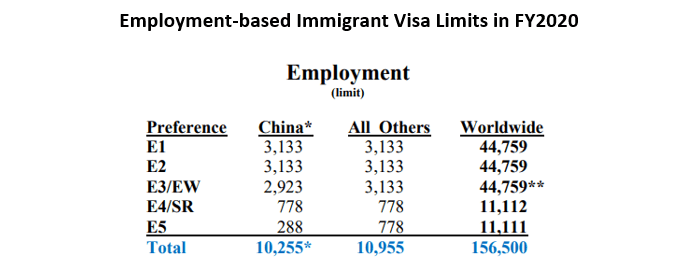Last week, the U.S. Department of State published the annual numerical limits on both family-based and employment-based immigrant visas for fiscal year (FY) 2020, including EB-5:
Table 1: Employment-based Immigrant Visa Limits in FY2020
Here are three things that we know about with regard to EB-5 visa availability in FY2020 (and beyond):
1. Additional 1,111 visa numbers will be allocated to EB-5 in FY2020.
A total of 11,111 immigrant visas will be allocated to the EB-5 category in FY2020, which means 1,111 additional visas will be available to EB-5 applicants worldwide. Because of the unused visa numbers left in the family-based categories in FY2019, the employment-based categories are going to receive additional visa numbers in FY2020 for total of 156,500 visas, 12% higher than the regular annual limit (140,000). Since the EB-5 category is entitled to 7.1% of the annual employment-based visa allocation – that is approximately 11,111 visas available to EB-5 applicants in FY2020.
2. EB-5 visa per-country cap will be 778 in FY2020, 10% higher than the regular limit.
With the additional 1,111 visas available to the EB-5 category in general, the per-county cap of EB-5 visa number use for FY2020 will be 778, 10% higher than the regular limit (approximately 700 visas). That means, at least 778 EB-5 visas will be reserved for visa applicants from each country across the globe (except for China because of the Chinese Student Protection Act, “the CSPA,” see below for more details). Without doubt, this is a good news for EB-5 visa applicants from India and Vietnam because additional 78 EB-5 visas will be reserved for applicants from these two countries respectively to alleviate their current EB-5 visa backlog in FY2020.
3. FY2020 is the last year that CSPA takes visa numbers away from the annual limit for China.
Because of the CSPA (P.L. 102-404), 700 visas have be automatically deducted from the annual EB-5 visa limit for China since 1992. However, things are going to change in FY2020 and beyond. The Department of State stated in its annual numerical limit for FY2020: “Approximately 700 numbers remain to be offset under this provision (the CSPA), with a total of 210 numbers being deducted from the E3 category, and 490 from the E5 category.” That is, only 490 visa number will be deducted from the annual EB-5 limit for China in FY2020 (instead of 700).
In addition, IIUSA confirmed with Mr. Charlie Oppenheim, Chief of Immigrant Visa Control & Reporting Division at U.S. Department of State, that FY2020 is very likely to be the last year that the CSPA will affect the annual visa limit for China, indicating that the accumulated deduction will meet the CSPA requirement by the end of the current fiscal year, and hence the CSPA provision will not continue to apply after FY2020.
However, it is also important to point out that the CSPA has not had any actual impact on the EB-5 visa availability for the Chinese applicants in the past because more than 4,300 otherwise unused EB-5 visas have been allocated to China every year (see IIUSA’s analysis here for more details). As the CSPA deduction for the China annual limit does not affect the overall EB-5 visa availability, over 4,300 EB-5 visa number have otherwise been unused every year in the past and available to any applicants solely based on their priority date regardless their country of birth (including China). As a result, EB-5 visa applicants from China with a much earlier priority date have been able to use all of the otherwise unused EB-5 visa numbers in the past despite the CSPA provision.









